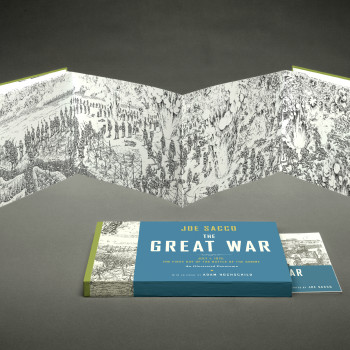A journalist and comic book artist, Joe Sacco uses the medium of graphic novels to tell non-fiction events in striking ways. In “The Great War: July 1, 1916, The First Day of the Battle of the Somme ” he focuses in on a single day in a single battle of WWI in great detail. The entire book is one intensely illustrated panorama of the battlefield and creating it left some emotional scars on the artist.

Rico Gagliano: Now, until this work I have to say I knew of the Battle of the Somme mainly from hearing it mentioned by British characters in various Masterpiece Theater shows.
Joe Sacco: Right.
Rico Gagliano: Clearly it looms larger though in the British mind. Tell us: why is that?
Joe Sacco: I would say the enormous number of casualties they suffered there. On the first day alone there were 60,000 casualties – 20,000 of those were deaths. And I mean, to put this in perspective, the estimates are in the first hour 10,000 British soldiers were killed, which is more than all the American servicemen killed in Iraq and Afghanistan combined.
Rico Gagliano: Generally lay out for us what the British plan was, because they didn’t think they were going to suffer like this.
Joe Sacco: No they didn’t. I mean, what they did is they prepared an enormous bombardment on the German trenches which actually went on for seven days. It was really enormous. So the British soldiers were told, you know, you’ll just walk into the trenches and you’ll find no one alive. But enough of them survived so that when the British went over the top, the Germans were able to you know, machine gun the troops as they came along.
Rico Gagliano: What is striking to me about all of this is how the commanders could have been so certain they would have succeeded and let these obvious details go. How is that possible that they could not have thought of things like, “Well maybe these guys are dug pretty deep and this relentless bombardment isn’t gonna do anything?”
Joe Sacco: Well, I mean, you know I think they thought seven days would be enough, but it wasn’t the sort of bombardment as you’re suggesting that dug deep into the German – the dugouts.
Rico Gagliano: But why?
Joe Sacco: Well that is the question I asked myself as I was drawing. You know: why? I’m not sure I can put my finger on what went wrong but to say that things went wrong. It was basically you had flesh moving across open ground into machine gun bullets and artillery fire. It’s flesh versus the machine age. That is what was wrong about the First World War
Rico Gagliano: In the sense that maybe it was being planned according to the rules of a previous war where there wasn’t so much machinery?
Joe Sacco: That might be the case. I mean, generals always sort of plan for the last war they say in general in warfare. For example, the French in World War II, had the Maginot Line. They expected the trench warfare would return, fortifications would be very important, but it was a war of movement by that point.
Rico Gagliano: I imagine you came into this knowing something of this battle. In researching what most surprised you about it?
Joe Sacco: Well I mean I’ve been reading about this battle since I was about 10 years old. It always kind of fascinated me. I think the thing that surprised me most was the enthusiasm of the British soldiers going into the battle.
The British soldiers who signed up in 1915 didn’t want the war to be over by Christmas. They wanted to get into it. Soldiers enlisted with their villages, with their friends. There were even pals battalions where you could enlist with your pals. They wanted to get in there, they thought it would be sort of a cake walk, and so there was a great enthusiasm.
But I think this is the battle where you know, there could be no more illusions about what the war was about and what it would be like. And by the next year you had the French army mutinying rather than going over the top again.
Rico Gagliano: The moment where the romance of battle is finally erased.
Joe Sacco: Unfortunately I think the story of humanity is that the romance of battle is always there, and it has to be re-erased and re-erased over and over again by each generation.
Rico Gagliano: Is that what you want us to take from this piece? That we have to keep reminding ourselves this is not, you know, a movie?
Joe Sacco: I wanted it to be something that sort of hit me in the gut. And when I was researching the book at the Imperial War Museum, you know, what I was sort of struck by was the official photographers didn’t take a lot of pictures of the dead. And the casualties, the British casualties, were mostly sort of cheerful.
Rico Gagliano: That’s how they were portrayed?
Joe Sacco: Yes. And I sort of based a lot of my drawings not on photographs, but on prose accounts by veterans who had been there. I thought I wanted to try to turn those into images.
Rico Gagliano: The panorama is in black and white. You have done a lot of work in black and white, but this is the sort of thing that could have obviously had a lot of impact from, for instance, a lot of red. What was your thinking in keeping it to the black and white palate?
Joe Sacco: Well, black and white is what I kind of know. Frankly I’m glad I didn’t have to use red, because, you know, it’s not pleasant to draw the bodies, and I think the color would have made it that much harder to depict.
Rico Gagliano: Emotionally for yourself?
Joe Sacco: Yes, that’s right. I mean to be honest, I don’t like drawing this sort of stuff. When I agreed to do this project, I didn’t really think about it too much. Then when you get the people going over the top, you have to draw their wounds and you sort of decide, “Oh well this one will still be okay, and this one next to him will be badly wounded, you know maybe he’s lost a limb.”
In some ways when you’re drawing people, you have to sort of be in the moment. You kind of have to inhabit everything you draw, and it’s something I felt with my previous work, and it’s something I’m getting a little fed up with at this point. But you now, you just feel like here I am doing this and I’ve just got to do it right.
Rico Gagliano: You feel I guess a responsibility then? It’s like you’re the guy that can bring these things to life and it’s important.
Joe Sacco: Well that’s true to some extent. I mean, I just did a journalism story out of Srebrenica, and part of me didn’t want to do it, but part of me felt like “No, you know this stuff well, you understand how to get this story.” And drawing that particular story was really again just unpleasant.
I want to get back to that moment 20-25 years ago when every morning I looked forward to going to the drawing table.


